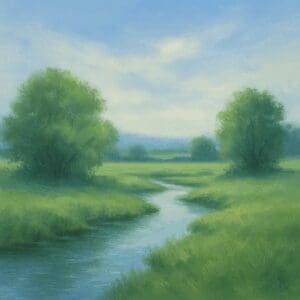Introduction
En plein air painting, or painting outdoors, is a captivating way to capture the beauty of landscapes. Whether you’re a beginner or an experienced artist, working with acrylic paints in the open air provides unique challenges and opportunities. In this guide, we will explore the step-by-step process of creating a stunning landscape en plein air using acrylic paint. By following these techniques, you’ll be able to immerse yourself in nature, capture its essence on canvas, and showcase your artistic skills. Let’s dive into the world of plein air painting with acrylics!
1. Choosing the Right Materials :
Before setting out to paint en plein air, it’s essential to gather the necessary materials. Acrylic paints are a popular choice for outdoor painting due to their versatility, quick drying time, and ease of use. Ensure you have the following materials:
– Acrylic paints: Select a basic set of colors, including primary colors, earth tones, and greens commonly found in landscapes.
– Brushes: Pack a variety of brushes, including flat and round brushes of different sizes.
– Palette: Choose a palette suitable for mixing your colors, such as a plastic or wooden palette.
– Canvas or painting surface: Opt for pre-stretched canvases or canvas panels, keeping in mind the size and format you prefer to work with.
– Easel: Use a sturdy and portable easel that suits your painting style and offers stability outdoors.
– Additional materials: Don’t forget to bring water containers, paper towels, a sketchbook, pencils, and any other tools you find useful.
2. Selecting a Suitable Location :
The choice of location plays a significant role in plein air painting. Look for a spot that inspires you and offers an engaging subject, such as a picturesque landscape, an interesting tree, or a tranquil river. Consider factors like lighting, composition, and accessibility.
– Lighting: Observe how the light changes throughout the day and choose a time when it complements your desired scene.
– Composition: Identify a focal point and determine how other elements will interact within your composition. Consider using the rule of thirds or other composition techniques to create balance and visual interest.
– Accessibility: Ensure that the chosen location is easily accessible, and you have permission to paint there. Be mindful of safety and local regulations.
3. Preparing and Sketching :
Before applying paint to canvas, it’s beneficial to spend some time preparing and sketching the scene. This step helps you plan your composition and understand the relationship between different elements. Consider the following:
– Observational sketch: Use a pencil and sketchbook to make quick observational sketches of the scene. Pay attention to shapes, lines, and proportions.
– Thumbnail sketches: Create small thumbnail sketches to explore various compositions and find the most compelling arrangement of elements.
– Value studies: Experiment with different tonal values to understand the distribution of light and shadow within your composition. This will aid in creating depth and dimension in your final painting.
4. Building the Painting :
Once you have your sketch and preliminary studies, it’s time to start building your painting. Follow these steps to bring your landscape to life with acrylic paints:
– Blocking in: Begin by blocking in the major shapes and colors using larger brushes. Use thin layers of paint and focus on capturing the overall tonal values and color relationships.
– Layering and texture: As the initial layers dry, start building up additional layers of paint to refine details and add texture. Experiment with various brush techniques to create different effects, such as dry brushing for texture or glazing for translucent layers.
– Capturing light and shadow: Observe how light interacts with the landscape and paint the areas of light and shadow accordingly
. Use lighter values to depict highlights and darker values for shadows. Consider the direction and quality of light to create a sense of depth and atmosphere.
– Adjusting colors: Continuously compare your painting to the scene and make adjustments to the colors as needed. Remember that colors can appear different in natural light, so be attentive to the subtle shifts in hues.
– Final touches: Once you are satisfied with the overall composition and color scheme, focus on adding the final details that bring your painting to life. Pay attention to smaller elements, such as tree branches, grasses, or reflections in water.
5. Tips and Tricks :
– Work efficiently: Due to the quick-drying nature of acrylics, work swiftly and keep your palette moist. Mist your palette with water occasionally to prevent the paints from drying out too quickly.
– Simplify your subject: Simplify complex scenes by focusing on the essential elements. Avoid getting caught up in unnecessary details that might overwhelm your composition.
– Embrace the weather: Weather conditions can add character to your painting. Experiment with capturing the effects of changing light, shadows, and atmospheric conditions.
– Practice regularly: Plein air painting is a skill that improves with practice. Dedicate regular time to painting outdoors and challenge yourself to explore different locations and subjects.
Conclusion:
Painting a landscape en plein air with acrylic paint offers a fulfilling artistic experience, allowing you to connect with nature and create vibrant artworks. By following the steps outlined in this guide and honing your skills through practice, you’ll develop a keen eye for observation, color mixing, and capturing the essence of the outdoors. Embrace the joy of painting en plein air and let your creativity soar in the breathtaking landscapes around you. Start your artistic journey today and discover the wonders of acrylic plein air painting!
Disclaimer: The views and opinions expressed in this article do not necessarily reflect the official policy or position of Irish Artmart.





